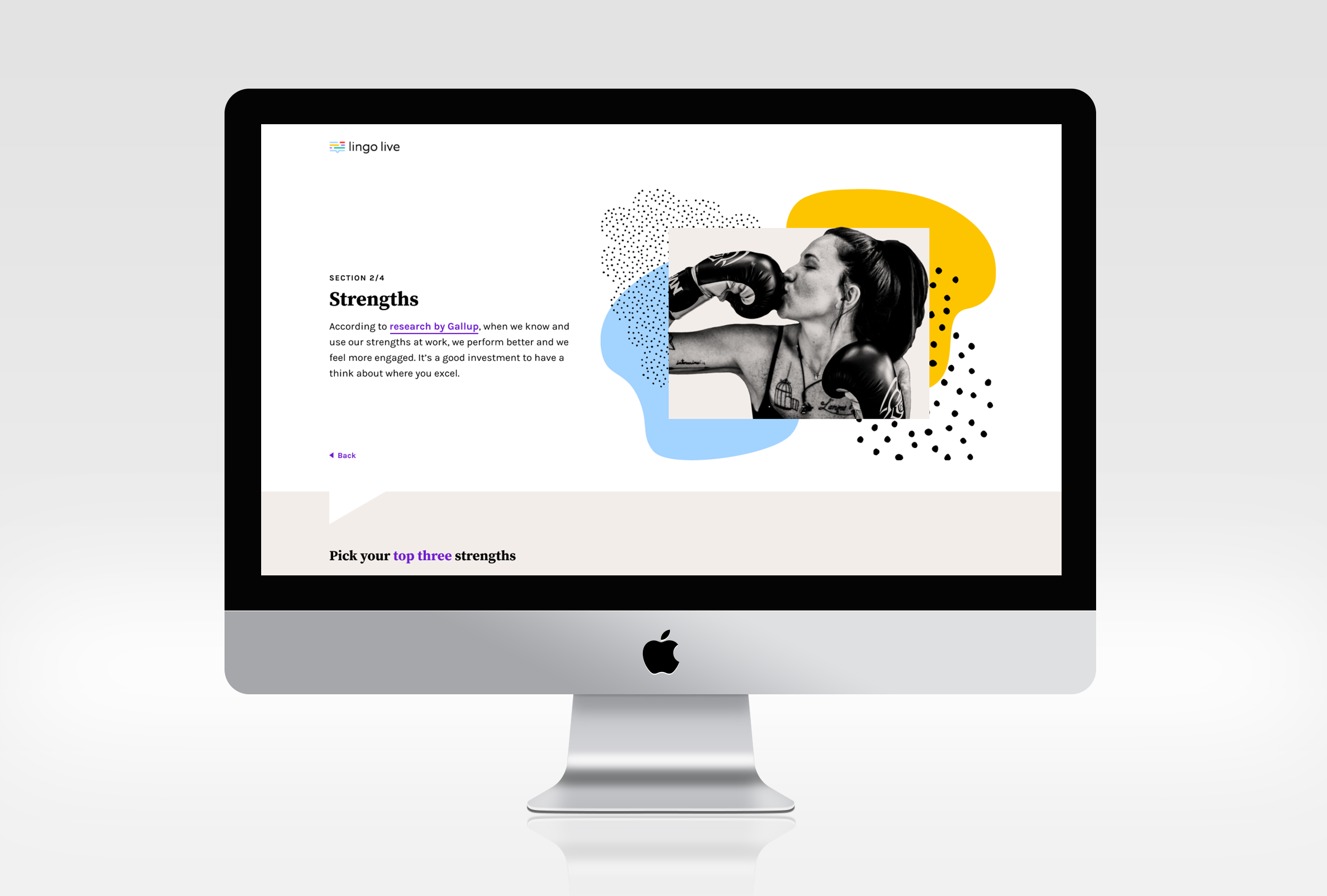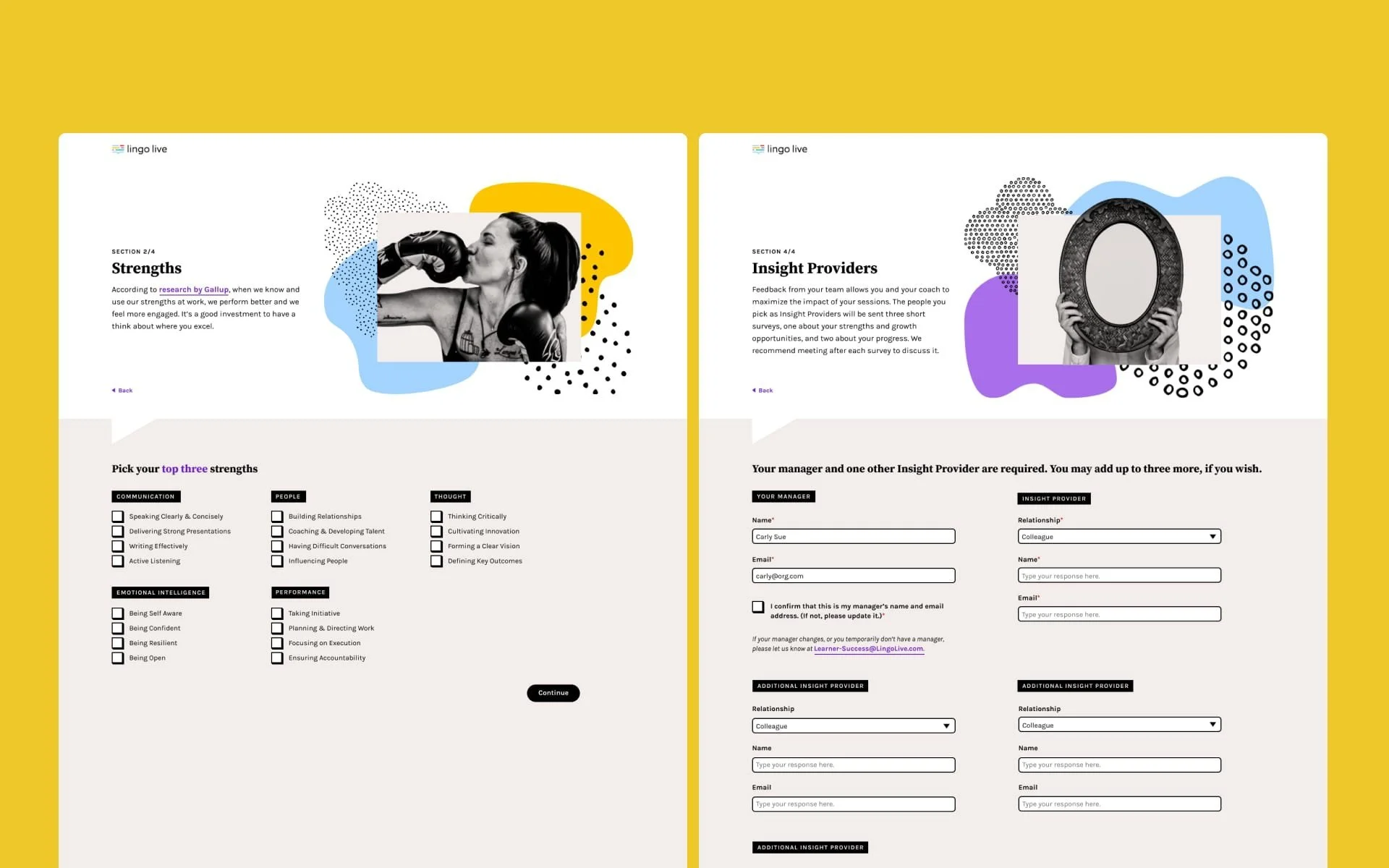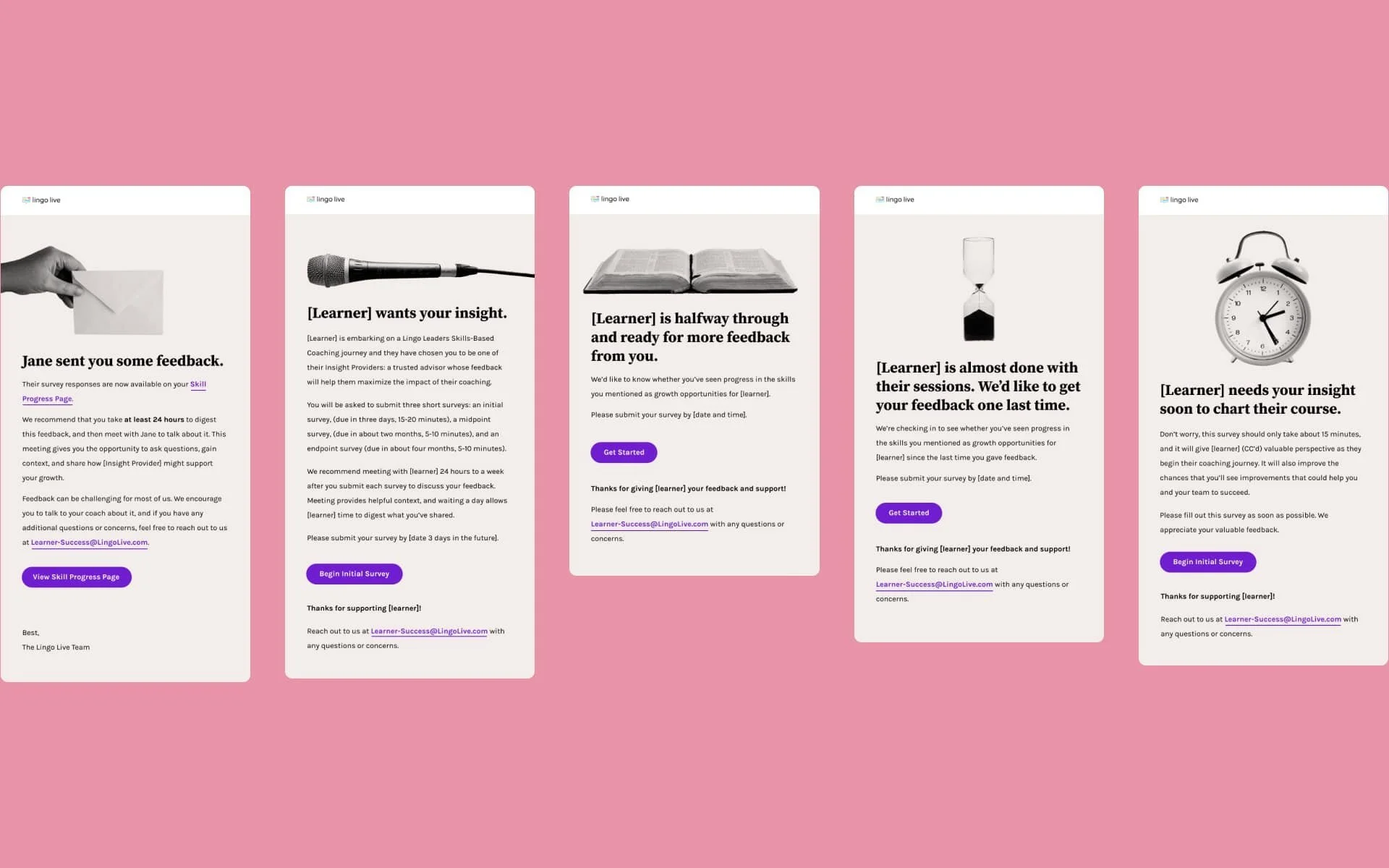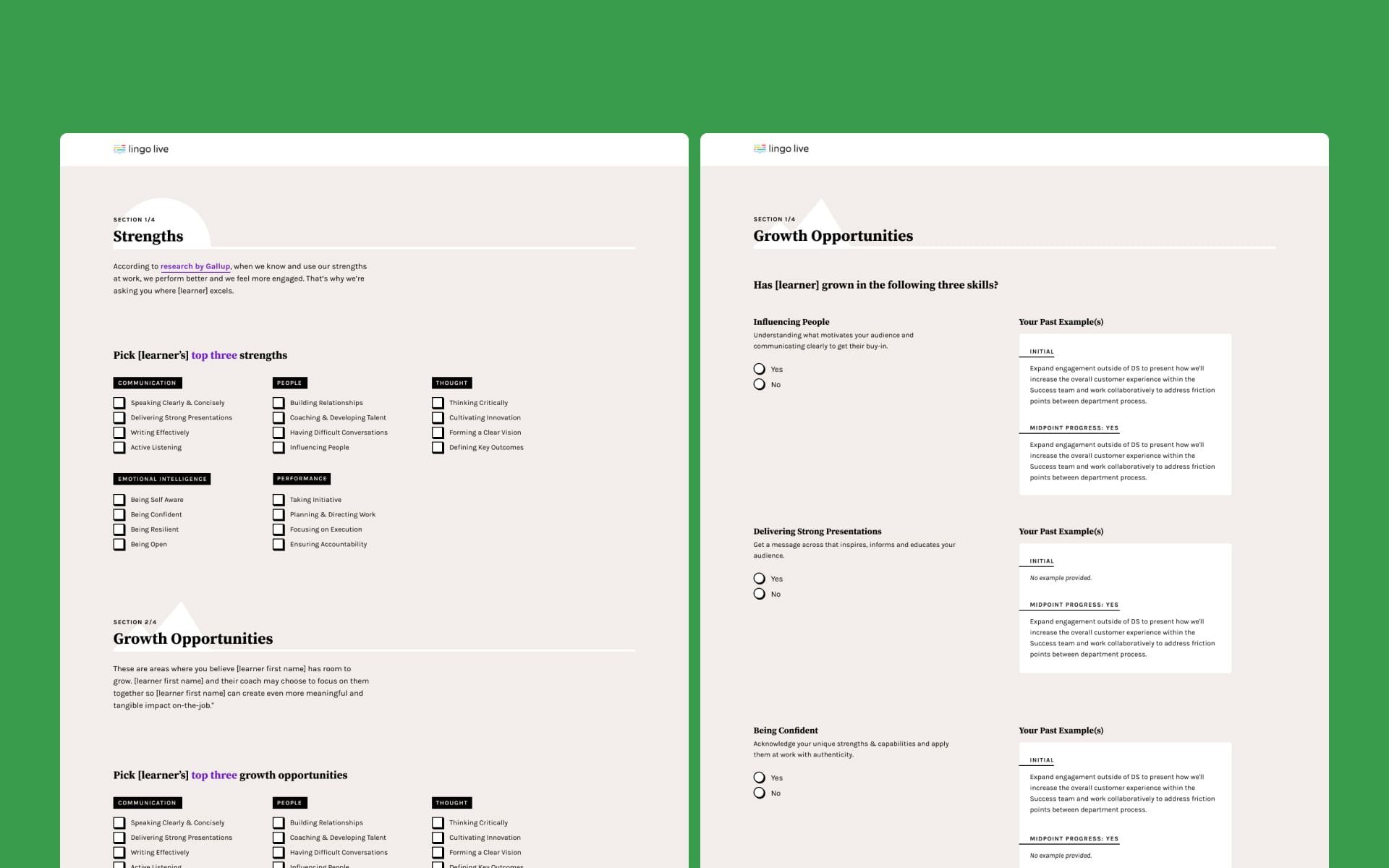Rethinking progress tracking to focus on goals and feedback
With surveys, emails, and a learner profile page
OVERVIEWMy role
Research
Product design
Team
Product Manager
3 Engineers
Company
Lingo Live
BRIEFHelp Lingo Live clients prove that their coaching program led to skill acquisition and improved job performance.
Overview
Lingo Live is a B2B coaching company that provides one-on-one leadership coaching for new managers. Business success depends on clients who are Learning & Development leaders at their companies proving ROI to their leadership teams to expand their programs.
Why did this project exist in the first place?
The learning team had developed a new Skill Catalog to help clarify what learners were learning in their sessions. We knew our L&D clients were struggling to prove the ROI of their programs, so we wanted to use the new Skill Catalog to help drive better ROI data.
What did our users say?
I interviewed seven prospects and former customers who closely matched our Ideal Customer Profile and five coachees who had recently participated in a pilot program to better understand their needs. Clients were keen to see baseline, midpoint, and endpoint data to improve learner-manager alignment and better measure progress. They also wanted to avoid survey fatigue.
I designed a four-part solution: a learner onboarding survey, an email campaign, progress tracking surveys, and a learner profile page.
OUTCOMES0169% increase in user activity in the first 14 days
0244% increase in users session completion in the first 30 days
0344% increase in the percentage of surveys completed
01Learner Onboarding SurveyGuide learners through picking focus skills and recruiting a feedback team
This is the learner onboarding survey where they pick focus skills.
The problem“Progress” is too ambiguous. Clients wanted to know what we meant by it.
Missed opportunity for manager alignment. Clients wanted learners to get input before the program to encourage alignment.
The goalSpecify what progress means. Whether we implemented a proficiency scale or a description, we needed to get more specific.
Invite the manager in. We made the learner’s manager a required member of their feedback team and recommended checking in.
The solutionPick focus skills to track. We clarified the ambiguity of progress by asking the learner to pick three skills to focus on from our Skill Catalog. That way we could ask the learner and their feedback team about those skills specifically instead of asking about progress in general.
Recruit a feedback team. The last step of the onboarding survey asks the learner to provide the names and emails of their feedback team. Their manager is required to be a part of the team—clients overwhelming wanted managers involved and our research indicated it improved results.
“It is so helpful for the learner to share what they want to work on, commit to that, and modify their behavior so that when we go back in 3 or 6 months the coachee says, ‘Yes, I’ve seen a marked difference.’ It persuades our execs of the value of this program.”
Laura, Mattel, L&D Client
02Email CampaignNotify learners and their feedback teams about giving and receiving progress feedback
Learners and their feedback team members receive survey notification emails.
The problemMissed opportunity for manager alignment. Clients wanted coachees to get manager input before the program to encourage alignment with team and business goals.
The goalInvite the manager in. We made the learner’s manager a required member of their feedback team and to recommended that the meet to discuss feedback regularly.
The solutionTimely reminders—off the platform. We learned that learners spent minimal time on the platform, so we needed another channel to notify and remind them and their feedback teams about surveys. Email was a natural fit. We took advantage of the format to inject a bit of our playful brand personality. We also provided our success team catch-all email in case learners were struggling with something and needed support.
03Progress Tracking SurveysCollect enough data to keep tabs on progress without inducing survey fatigue
Learners and their feedback team submit surveys tracking focus skills.
The problemWe needed more robust data. We needed to curvey before, during and after to have enough data and clients also wanted to keep surveys minimal because they already had many of their own.
The goalSurvey everyone throughout the program. We created super-short baseline, midpoint and endpoint surveys for the learner and their feedback team.
The solutionShow an arc. We created progress surveys that went out at the beginning, middle and end of the program so there was a baseline for comparison (the original impressions of the learners ability in the three focus skills), a read at the mid-point, which provided an opportunity for course correction, and a final survey to show the total progress over the course of the experience.
Keep it simple. Ask for examples. These three surveys are only three questions long. In the first one, we ask for impressions of the learner’s ability in the focus skills and we ask for examples. For the following surveys, we ask if progress has been observed and ask for examples. We considered complex proficiency rating systems, but in the end decided that a simple yes or no to progress was helpful on its own, and specific examples were the simplest and most clear ways of demonstrating the impact concretely.
“Getting feedback at the midpoint is huge because we can see if what we are doing is working and adjust accordingly. Directly involving the feedback team creates more accountability and focus.”
Keith Turner, Lingo Live Coach
03Learner Profile PageGive the learner a home for all their and feedback for self-reflection and as a conversation starter
The learner profile page houses all self-reported and team feedback data.
The problemBefore-and-after data to show change. Clients didn’t only want to know whether coachees had made progress, they wanted to know how much. They suggested proficiency scales.
Missed opportunity for manager alignment. Clients wanted coachees to get manager input before the program to encourage alignment with team and business goals.
The goal
Survey everyone throughout the program. We needed to ask before, during and after the program so we had a baseline for comparison, and an opportunity to intervene.
Invite the manager in. We made the learner’s manager a required member of their feedback team and to recommend that the meet to discuss feedback regularly.
The solutionCreate a complete picture. Human beings have a negativity bias, so easy to focus on where we still have room to grow, and forget how much progress we’ve made. We created a Learner Profile Page to celebrate the learner’s growth, remind them of it, and prompt reflection about what skills and goals to focus on next.
Sustain a professional development conversation. We wanted to encourage the learner to share their coaching experience with their manager, yes, because L&D Admins wanted learner’s program goals to be aligned with their manager’s team goals, but also because the learner’s manager is a powerful resource for their continued professional development. If we could provide a window for them into the progress the learner has been making, they could provide them with relevant stretch assignments and continue to nurture their growth after the program is over.
“I really like the new functionality and how the information is delivered to the learner. In the past, I found it difficult to find review feedback to see how I have improved. This information is invaluable in the learning process.”
Benjamin, Lingo Live Learner





